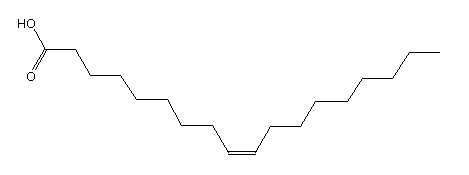7 most-asked questions about trans fats

Monounsaturated fats are "good"; saturated fats are "bad"; but what about trans fats? They've been banned in California and listed on fast food menus in New York. How bad are they really? I've sorted through the research to bring you the answers to 7 essential, need-to-know queries.
1. What are trans fats?
They are chemically classified as unsaturated fatty acids but the molecules have been "rearranged" or "straightened" so they act like saturated fatty acids in the body. Compare oleic acid, a common monounsaturated fatty acid in many foods, with its trans cousin elaidic acid below. Both have the same number of carbon atoms but oleic is bent at the double bond while elaidic (the trans one) sits straight in line - which alters the way it behaves in food manufactaure.
Here is oleic acid (a monounsaturated fatty acid) with 18 carbons and a bend or 'kink' in the middle of its long chain at the double bond:

Here is elaidic acid (a trans fatty acid), also with 18 carbons in its chain, but no 'bend' at the double bond.

2. Why are trans fats used?
They have a higher melting point than non-trans or "cis" fats. This means they are more solid at room temperature and under heating which makes for crisper biscuits and crunchier chips, nuggets and corn chips. They are also more stable, less likely to go rancid so have a longer shelf life.
3. Are they synthetic or natural?
One type of trans fats is made by bacteria in the forestomachs of cattle, sheep, goats and deer and so occur naturally in the meat, milk and other products derived from these animals.
The other worrying type of trans fats is formed through the hydrogenation of liquid vegetable oils. They're the one nutritionists are concerned about.
4. What's the problem with industrial trans fats?
They increase your total cholesterol and "bad" LDL cholesterol levels and lower your "good" HDL cholesterol level, causing a deficiency of essential fatty acids. This significantly increases your risk of heart disease, type 2 diabetes and possibly infertility.
5. Is it worse in the US than in Australia?
Yes! In the US they've had to hydrogenate soy bean oil to produce hard commercial fats so their intake is much higher than ours. The average American consumes 2 to 3 per cent of his/her daily kilojoules from trans fats compared to 0.6 per cent for an Australian. What's more, most of our trans fats are naturally occurring and have not been shown to be dangerous.
Thanks to the Heart Foundation, which has been pushing manufacturers to get rid of industrial trans fats, we've been using palm oil which is high in saturates so already a semi-solid with good shelf life so doesn't need to be hydrogenated. It contains little trans fats but it's still not good for your heart.
6. Where do trans fats lurk?
At present most food labels show ONLY the total fat and saturated fat which makes it hard to track them down. Manufacturers have to list the trans fat only when they make a claim about them such as "Free of trans fat". Most margarines tell you their trans fat content as it's so low - usually less than 0.1 per cent.
As a general rule, foods likely to contain higher levels of trans fats are "junk food" - crisps, doughnuts, muffins, fast food, fried food, crisps, pies, doughnuts, microwave popcorn, instant fried noodles, meat pies, sausage rolls, apple pies and croissants- so eat less of those and you'll automatically reduce your intake.
7. Trans OR saturated fats - what's the real worry?
In Australia trans fats are not the problem they are in the US. What we do need to worry about is the amount of saturated fats we consume. So remember, don't choose foods based on trans alone try to choose products with the lowest total saturated plus trans fat content possible.
Trans fats in the news
Professors call for removal of industrial trans fats Two Harvard Medical School professors argue that removing industrial TFAs - with their partially-hydrogenated fats - is one of the most straightforward strategies for rapid improvements in health. They point to Denmark and New York City where legislation has forced removal of trans fats with no loss of food availability, taste or affordability. For instance, they say in New York restaurants, the prevalence of use of trans fat has declined from 50% to less than 2%. Editorial in British Medical Journal April 2010. Read more
Two Harvard Medical School professors argue that removing industrial TFAs - with their partially-hydrogenated fats - is one of the most straightforward strategies for rapid improvements in health. They point to Denmark and New York City where legislation has forced removal of trans fats with no loss of food availability, taste or affordability. For instance, they say in New York restaurants, the prevalence of use of trans fat has declined from 50% to less than 2%. Editorial in British Medical Journal April 2010. Read more
Surveys on the intake of trans fats
 Check out reports on how much trans fats we eat in Australia and New Zealand and what foods are the culprit contributors in this series of excellent reports from the food regulator FSANZ: Intakes of Trans Fatty Acids in New Zealand and Australia; Risk Assessment Report; Round table on Trans Fats in Quick Service Restaurants - Report on voluntary initiatives to reduce trans fatty acids in the the Australian Food supply. Read more
Check out reports on how much trans fats we eat in Australia and New Zealand and what foods are the culprit contributors in this series of excellent reports from the food regulator FSANZ: Intakes of Trans Fatty Acids in New Zealand and Australia; Risk Assessment Report; Round table on Trans Fats in Quick Service Restaurants - Report on voluntary initiatives to reduce trans fatty acids in the the Australian Food supply. Read more
In 2015, the Food and Drug Administration gave the food industry three years to remove industrial trans fats from the American diet. This follows its statement that partially-hydrogenated oils (PHOs), the source of artificial trans fats, were no longer “generally recognized as safe.” It is also present at very low levels in some oils, where it is unavoidably produced during the manufacturing process. In addition, food companies can petition FDA for specific uses of certain partially hydrogenated oils which are needed for special food uses. Read more from FDA



